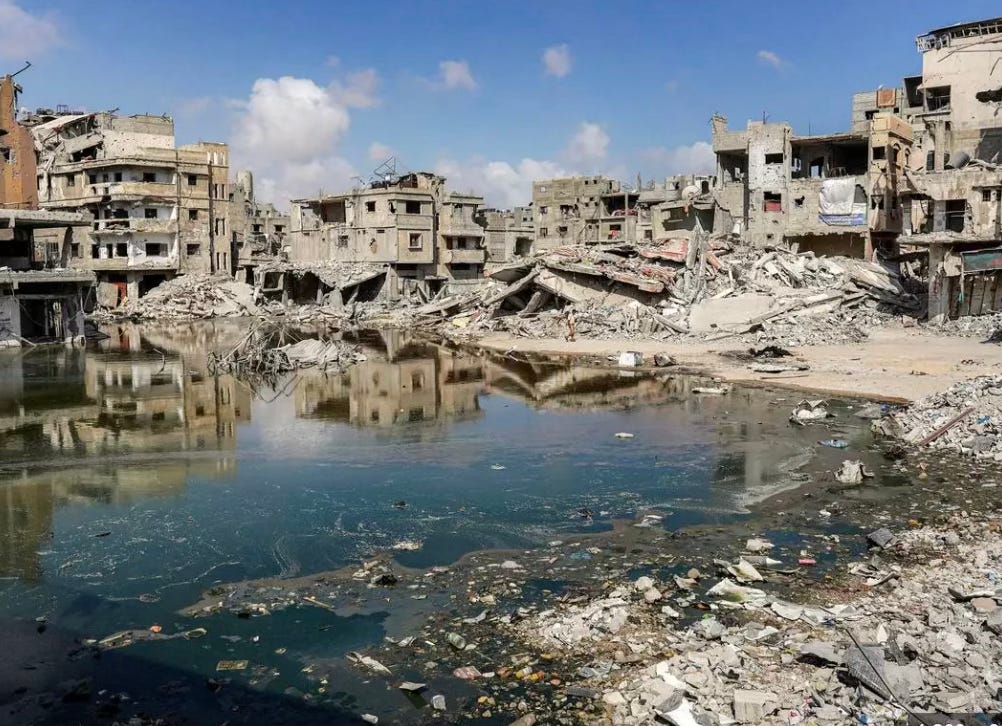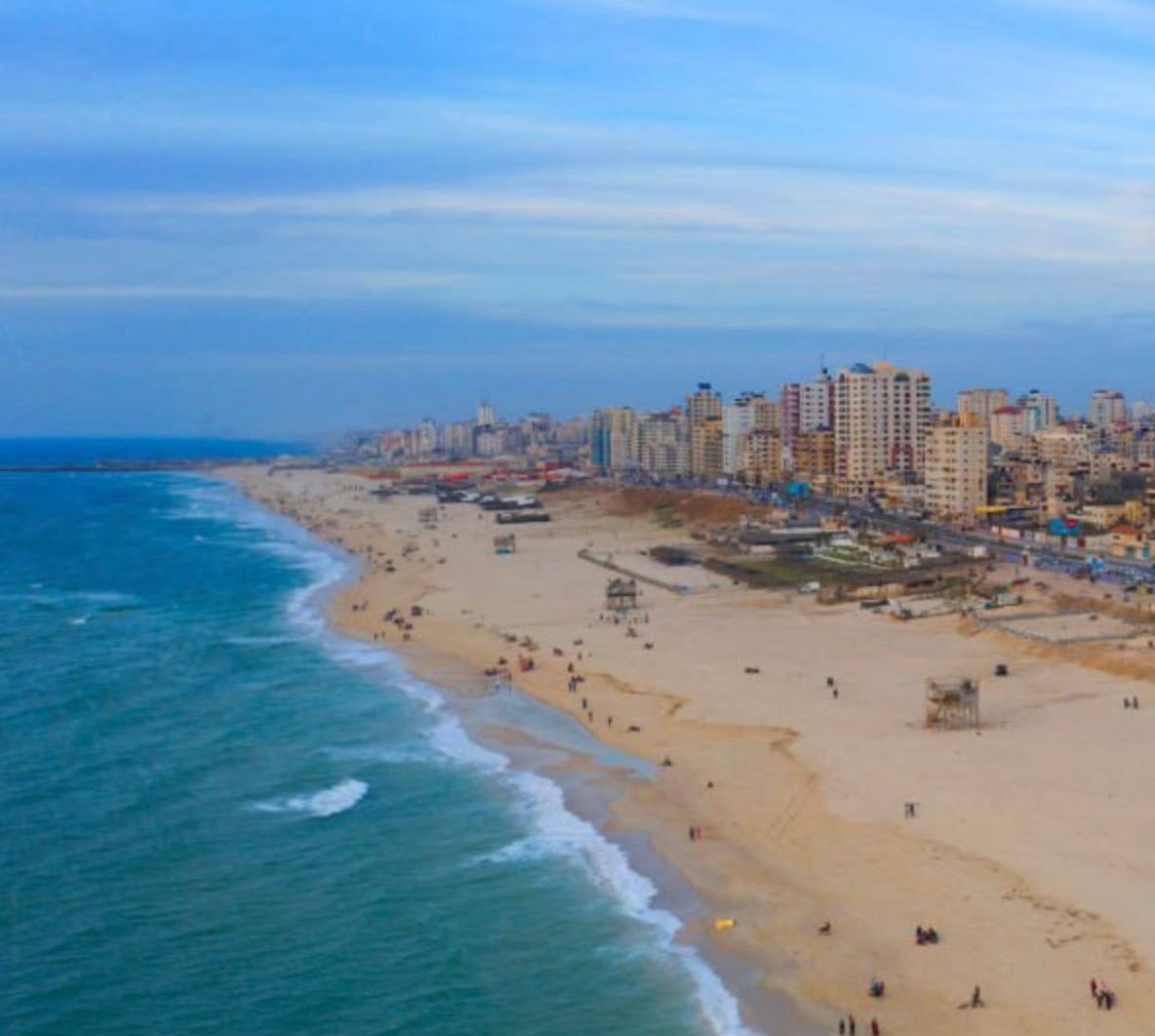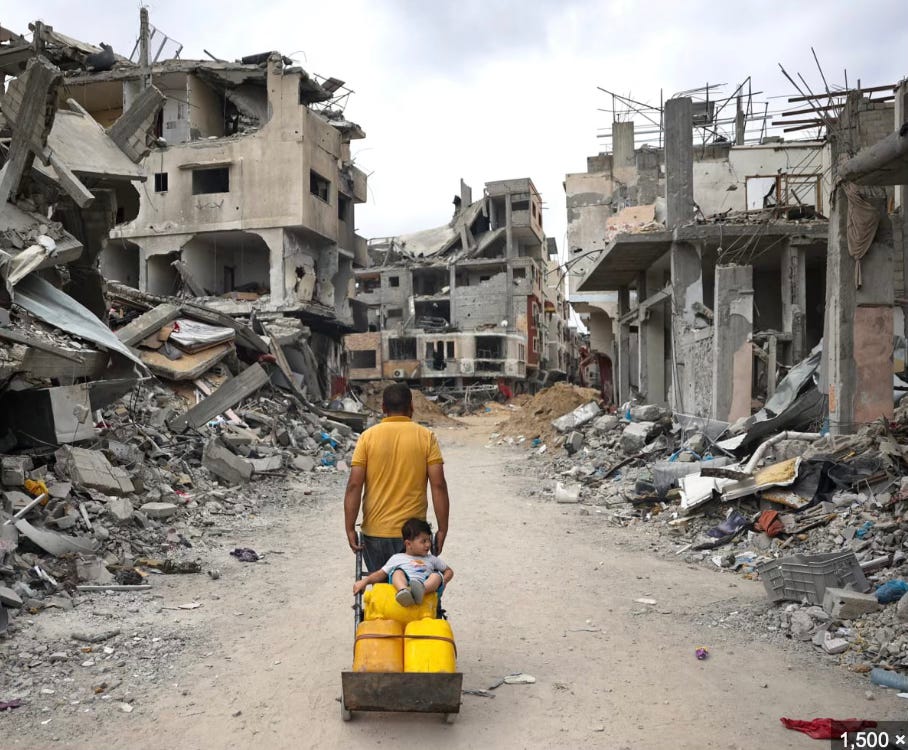"If I must die, let it bring hope, let it be a tale."
– Refaat Alareer
Imagine a gleaming Trump Tower rising along the Mediterranean coastline, its golden facade casting shadows over the rubble of what was once a bustling Palestinian town. Luxury beachfront resorts cater to wealthy tourists, while infinity pools and golf courses stretch across land that once belonged to families now gone. This glittering vision of ‘redevelopment’ would be presented as progress—a shining example of prosperity rising from destruction. But beneath the surface lies a darker truth: the systematic genocide of a people, their culture, and even their identity.
Gaza, one of the most densely populated areas in the world, is home to over two million Palestinians. It is a symbol of resistance, but its humanitarian crisis remains dire, with over 80% reliant on aid (OCHA, 2023). It is not a blank canvas for luxury resorts or economic experiments. It is a place of survival, a reminder of the decades-long struggle of a people fighting to remain on their land despite unimaginable hardships. Yet, in this hypothetical vision of redevelopment, Gaza becomes an analogy for something far more sinister: the final act of a long-running campaign of ethnic cleansing to obliterate Palestine and Palestinians from the map entirely.
A Vision of ‘Progress’
"If I must die, let my name become a seed for the fields of my land."
– Refaat Alareer
Just days into Donald Trump’s second term, he described Gaza as "a demolition site." This vision for Gaza, first shaped during his initial term, now seems to be gathering speed as the region reels from recent destruction by Israel. When asked if he would help rebuild it, he responded noncommittally, saying, "I might," and went on to mention the "beautiful seafronts" that could be transformed into something spectacular. Trump’s comments framed Gaza’s devastation as an opportunity for redevelopment, ignoring the widespread suffering caused by the near-total destruction of the region during Israel’s recent military campaigns (Times of Israel, 2025).
During Donald Trump’s first term, the Israeli-Palestinian conflict was repeatedly reframed through the lens of economics. This was evident in his administration’s Peace to Prosperity plan, which proposed economic investments but ignored political rights (Kushner, 2020). Critics argued that the plan sought to replace justice with financial incentives, effectively bribing Palestinians to relinquish their claims to land and sovereignty.
Now, imagine a Gaza transformed by this same ideology. Trump’s vision could feature sparkling hotels, bustling tourist attractions, and advertisements branding Gaza as ‘the next Dubai.’ The land would be marketed as an untapped jewel waiting to shine, with its original inhabitants erased from the narrative. Tourists might marvel at the redevelopment without ever considering what—or who—came before.
The People Under the Rubble: Building on Genocide
"If I must die, let the wind carry my voice, let the hills echo my pain."
– Refaat Alareer
For decades, Palestinians have resisted displacement, knowing that leaving their land often means permanent exile. Many carry the keys to homes they fled during the Nakba in 1948, passing them down through generations as symbols of their enduring hope to return. These keys are not just relics; they are acts of defiance against a system intent on ethnically cleansing their history and presence.
But if Gaza’s towns are emptied to make way for redevelopment, the people of Gaza will not simply disappear. Forced displacement violates international law under the Fourth Geneva Convention (Human Rights Watch, 2022). They will not leave willingly for the camps of exile, because they know what that means: genocide. If Gaza’s towns are emptied, the people will be under the rubble—literally and figuratively. Their destruction will be the foundation for this vision of ‘progress.’
The luxury hotels, gleaming casinos, and infinity pools would rise from the ashes of Palestinian homes, schools, and neighbourhoods. But this would not be development in any meaningful sense. It would be the culmination of a process of systematic destruction and removal—a genocide built into the foundations of a sparkling new Gaza.
Tourists might marvel at the shining skyline, sipping cocktails in rooftop bars that quite literally stand atop the rubble of Palestinian lives. The golden towers would become monuments to a genocide disguised as redevelopment. Meanwhile, beneath the carefully manicured lawns and luxury resorts, the foundations would remain haunted by the erased history of the people buried beneath them.
Ethnic Cleansing: A Genocide of Memory
"If I must die, let the stars write my story across the night."
– Refaat Alareer
This genocide is not only physical; it extends to memory itself. In the sanitized history of a redeveloped Gaza, the word ‘Palestinian’ might vanish entirely. The tourist-friendly ‘Old Town’ might describe the area’s “ancient heritage,” but its plaques would gloss over the truth. Carefully curated narratives would refer vaguely to “ancient Arab inhabitants” or “ancient Israeli settlements,” ensuring that even the memory of the Palestinians who lived and died there is obliterated.
Gaza’s plight is not a standalone tragedy but part of a larger pattern of Palestinian displacement and genocide. The 1948 Nakba and subsequent wars entrenched occupation and injustice (Alareer, 2015). The Nakba of 1948 displaced over 700,000 Palestinians, many of whom fled to Gaza. The 1967 Six-Day War further entrenched Israel’s occupation of Palestinian territories, compounding displacement and loss. Today, Gaza remains one of the most densely populated and impoverished areas in the world, its people trapped by blockades and recurrent cycles of violence.
The Fourth Geneva Convention explicitly prohibits the transfer of populations and the destruction of civilian property, yet these principles are consistently ignored in Palestine. International treaties designed to protect the rights of occupied peoples have become toothless in the face of geopolitical interests, leaving Palestinians to endure systematic injustice.
Years later, a tourist standing on the balcony of the Trump Hotel might gaze out over the Mediterranean and wonder: Who lived here before? Arabs, maybe? Or ancient Israelis? The plaques and curated walking tours would provide no answers, because this is what genocide does—it eliminates not only the people but the stories they left behind.
The keys carried by exiled Palestinians would remain as painful symbols of lives stolen. But how long can even symbols endure when the world remains complicit in the rewriting of history?
Global Complicity: The Silent Endorsement of Genocide
"If I must die, let my dream outlive me, let the future remember my name."
– Refaat Alareer
The silence of global complicity drowns out the cries of a people whose stories deserve to be told.
During Trump’s first term, the U.S. Embassy was moved to Jerusalem in 2018, a symbolic gesture that many saw as tacit approval of Israeli actions in Palestine. This act not only emboldened Israeli settlement expansion but also marked a significant shift in U.S. policy, effectively sidelining Palestinian aspirations for sovereignty.
The international community has long been complicit in Palestinian suffering. When entire villages in the West Bank are bulldozed to make way for Israeli settlements, global responses are tepid at best: brief statements of condemnation, followed by a resumption of normal diplomatic relations. Countries in the Arab world, many of which are normalizing relations with Israel, have turned a blind eye to the continued ethnic cleansing of Palestine. Economic and geopolitical interests increasingly outweigh solidarity with the Palestinian cause.
Meanwhile, tourism in places of genocide sanitizes colonial narratives, offering luxury at the expense of local history and suffering. Gaza’s transformation into a Trump-branded paradise would likely follow this pattern, with tourists enjoying curated experiences that obscure the destruction beneath their feet.
A Call to Action
The redevelopment of Gaza as a luxury destination would be more than an architectural transformation. It would be an act of genocide—a deliberate effort to replace a people and their history with a sanitized, commodified version of reality. It is not enough to watch silently as history is rewritten. Gaza’s story must remain one of resistance, not of genocide.
The international community must act decisively to uphold international law, protect human rights, and resist the forces that seek to ethnically cleanse Palestine entirely. This requires more than empty statements; it demands tangible action, such as sanctioning violations of international law, supporting Palestinian self-determination, and amplifying Palestinian voices in global discourse.
As tourists sip cocktails above the ruins of Gaza’s villages, the keys to homes lost in exile will remain in the hands of those who refuse to let their identity and history be forgotten. But the world must do more than remember; it must act. Otherwise, Gaza’s transformation will stand as a choice: a triumph of resistance or a monument to genocide.
In memory of Refaat Alareer - (September 23, 1979–December 6, 2023)
References
Kushner, J. (2020). Peace to Prosperity: A Vision to Improve the Lives of the Palestinian and Israeli People. The White House Archives. Available at: https://trumpwhitehouse.archives.gov (Accessed: 24 January 2025).
OCHA (2023). Humanitarian Needs Overview for the Occupied Palestinian Territory. United Nations Office for the Coordination of Humanitarian Affairs. Available at: https://www.unocha.org (Accessed: 24 January 2025).
UNRWA (2023). Gaza Strip: Facts and Figures. United Nations Relief and Works Agency. Available at: https://www.unrwa.org (Accessed: 24 January 2025).
Human Rights Watch (2022). Israel and Palestine: Events of 2022. Available at: https://www.hrw.org (Accessed: 24 January 2025).
Amnesty International (2023). Israel's Apartheid Against Palestinians: A Cruel System of Domination and Crime Against Humanity. Available at: https://www.amnesty.org (Accessed: 24 January 2025).
Alareer, R. (2015). Gaza Writes Back: Short Stories from Young Writers in Gaza, Palestine. London: Just World Books.
Times of Israel (2025). Trump describes Gaza as a demolition site and hints at potential redevelopment. Available at: https://www.timesofisrael.com (Accessed: 24 January 2025).






